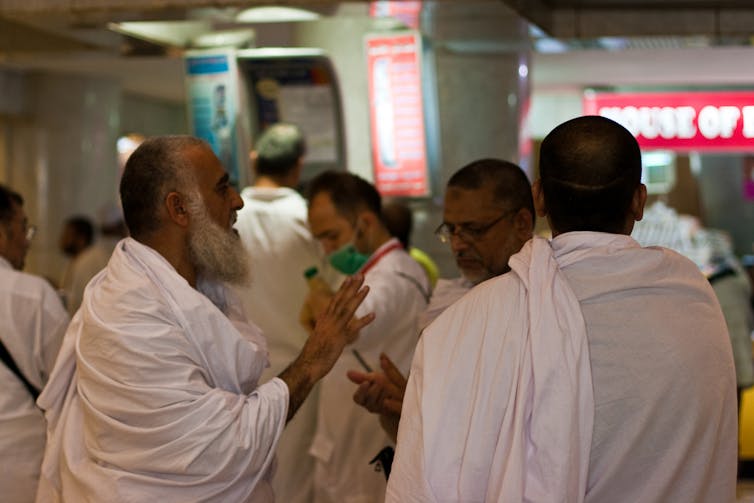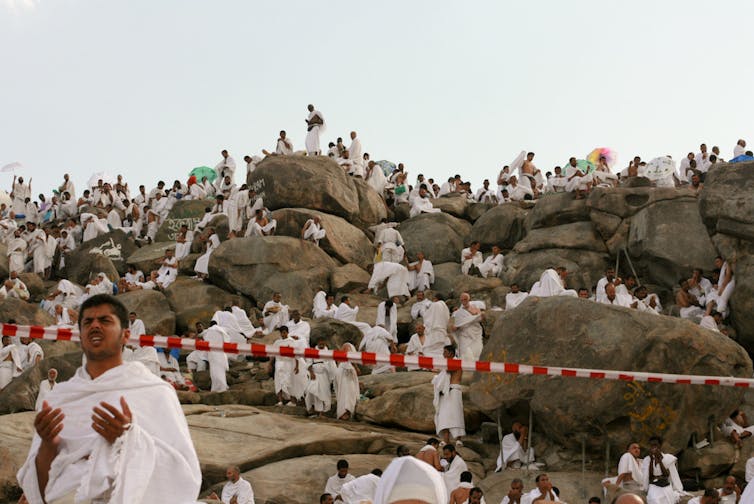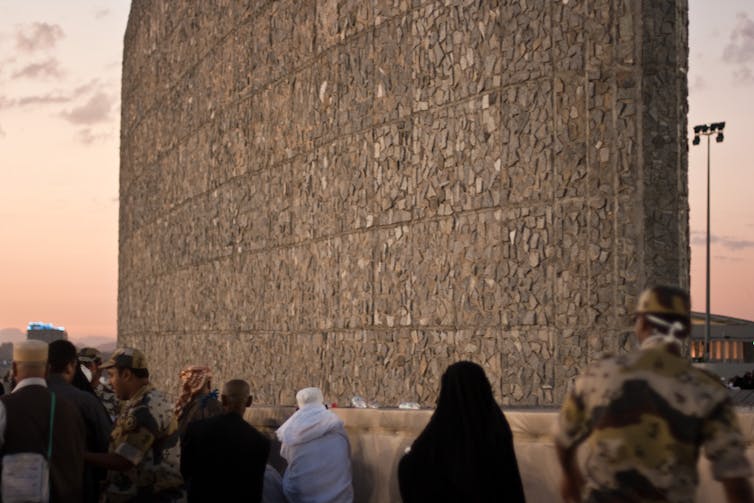The Muslim Hajj: A spiritual pilgrimage with political overtones
- Written by Ken Chitwood, Ph.D. Candidate, Religion in the Americas, Global Islam, University of Florida
Nearly 2 million Muslims[1] will gather in the holy city of Mecca in Saudi Arabia on Aug. 9 for an annual pilgrimage known as the hajj[2].
The five-day journey is a once-in-a-lifetime obligation[3] for all Muslims who are physically and financially able to undertake it. It is considered the fifth pillar of Islamic practice, along with professing faith, saying five prayers daily, giving to charity and fasting during Ramadan[4].
In calling Muslims to perform the hajj, the Quran says[5]: “Proclaim to men the pilgrimage: they will come to thee on foot and on every lean camel, coming from every remote path.”
The millions of Muslims from around the world who meet each year in Saudi Arabia dress simply to mask any differences in wealth and status. Women wear plain, white dresses and headscarves. Men drape themselves in seamless, unhemmed clothing.
As a scholar of global Islam[6], I’ve interviewed many Muslims who have gone on the hajj. They have described to me having profound experiences on the pilgrimage, both political and spiritual.
 Pilgrims dressed in white.
Al Jazeera English, CC BY-NC[7][8]
Pilgrims dressed in white.
Al Jazeera English, CC BY-NC[7][8]
The first day of the hajj
The rites of the hajj are believed to retrace events from the lives of prominent prophets like Ibrahim and his son Ismail.
Pilgrims start by declaring their intentions for the journey and then circling seven times the “Holy Kaaba[9],” the black, cube-shaped house of God located at the center of the most sacred mosque in Mecca.
In doing so, they join in a long line of pilgrims to Mecca who have circled the Kaaba, including Prophet Muhammad[10]. Some may also kiss, touch or approach the Kaaba as a sign of their respect and devotion. However, Muslims do not worship the Kaaba or any of its elements.
The Kaaba is so central to the Islamic faith that, across the world, Muslims pray in its direction.
After circling the Kaaba, pilgrims walk about 100 meters to two hills known as Safa and Marwah, where they recreate another significant event[11] recorded in the Quran.
After Ismail was born, God instructed Ibrahim to leave his newborn son and his mother Hajar out in the desert, and he complied. But when baby Ismail cried out with thirst, Hajar ran between these two hills, looking for water, until finally she turned to God for help.
God rewarded Hajar for her patience. He sent his angel Jibreel to reveal a spring, which today is known as Zamzam Well. Pilgrims drink water from the sacred well on the first day of the hajj before making their way to Mina – also known as the “tent city” – about three miles from Mecca, to perform their five daily prayers.
The second day of the hajj
The hajj climaxes with a sojourn in the plains of Arafat, nine miles from Mina.
There, pilgrims gather in tents and spend the day together in prayer and contemplation. Some pilgrims will also ascend a hill known as the Mount of Mercy, where an aged Prophet Muhammad delivered his farewell sermon[12].
For many Muslims, this period is the highlight of the hajj. Muslims believe that the spirit of God comes closer to Earth[13] in this place at the time of the pilgrimage.
In my conversations with pilgrims, many have told me they feel a close communion with God[14] when standing in the plains of Arafat.
 Pilgrims praying on Arafat.
Al Jazeera English, CC BY-SA[15][16]
Pilgrims praying on Arafat.
Al Jazeera English, CC BY-SA[15][16]
Final three days
After collecting pebbles at Muzdalifah, an open area near Mecca, pilgrims gather again in the tent city of Mina. There, they reenact another part of the story about Ibrahim and his son Ismail: when Satan tried to tempt Ibrahim to disobey God’s call to sacrifice his young son[17].
Ibrahim remained unmoved. Ismail, too, was willing to be sacrificed as a vow to God. To reenact this rebuff of Satan’s temptation, pilgrims throw their pebbles at a stone pillar.
Just as Ibrahim was about to kill his son, the Quran says, God intervened and a ram was sacrificed in place of Ismail. In remembrance, hajj pilgrims – or someone in their place – will sacrifice an animal. Muslims around the world join the sacrifice by celebrating Eid al-Adha[18], a ritual meal that this year falls on Aug. 10 and Aug. 11.
As a final sacrifice, pilgrims shave their head or cut off a portion of hair after the stoning of the pillar.
Many pilgrims will spend the next few days at Mina, repeating the stoning. Most will also return to the Holy Kaaba in Mecca at least once more.
 Pilgrims in Mina.
Al Jazeera English, CC BY-SA[19][20]
Pilgrims in Mina.
Al Jazeera English, CC BY-SA[19][20]
As the hajj draws to a close on days four and five, pilgrims start to put on their everyday clothes to indicate a transition back to their worldly life[21].
Muslims believe that a proper performance of the hajj can absolve Muslim pilgrims of any previous sins. But it is up to God to judge whether the pilgrimage was acceptable[22].
Unity over division
The hajj may be a holy journey for pilgrims, but for Saudi authorities it is also a massive organizational undertaking[23].
Crowd management, security, traffic and sectarian tensions are annual challenges[24]. A stampede in 2015 left more than 700 dead[25]. Saudi Arabia is constantly renewing its safety protocols[26] to protect the million of hajjis who flock to their country.
This year, concerns over Saudi human rights abuses have cast a cloud over the pilgrimage. Between the murder of journalist Jamal Khashoggi[27] and Saudi Arabia’s involvement in the Yemeni civil war[28], some pilgrims are debating whether travel to the country is morally acceptable.
In hopes of avoiding such conflicts of conscience, which can divide the ummah – the global Muslim community – many Muslims have called[29] for the Organization of the Islamic Cooperation[30], an intergovernmental group, to create an international, multi-partisan hajj organizing committee.
The hajj is any individual Muslim’s single most[31] symbolic ritual act that reflects the ideal of unity[32]. By requiring Muslims to don the same clothes, pray in the same spaces and perform the same rituals, the hajj can connect Muslims across national and class boundaries – but only when politics do not divide them.
This article is an updated version of a story[33] originally published on Aug. 31, 2017.
[ Sign up for The Conversation’s newsletter to get insight each day[34] ]
References
- ^ 2 million Muslims (www.thenational.ae)
- ^ the hajj (www.dictionary.com)
- ^ is a once-in-a-lifetime obligation (www.cambridge.org)
- ^ fasting during Ramadan (theconversation.com)
- ^ says (www.quranexplorer.com)
- ^ scholar of global Islam (florida.academia.edu)
- ^ Al Jazeera English (www.flickr.com)
- ^ CC BY-NC (creativecommons.org)
- ^ Holy Kaaba (www.oxfordreference.com)
- ^ including Prophet Muhammad (global.oup.com)
- ^ another significant event (www.cambridge.org)
- ^ farewell sermon (en.wikipedia.org)
- ^ spirit of God comes closer to Earth (www.oxfordreference.com)
- ^ feel a close communion with God (books.google.com)
- ^ Al Jazeera English (www.flickr.com)
- ^ CC BY-SA (creativecommons.org)
- ^ God’s call to sacrifice his young son (theconversation.com)
- ^ Eid al-Adha (theconversation.com)
- ^ Al Jazeera English (www.flickr.com)
- ^ CC BY-SA (creativecommons.org)
- ^ to indicate a transition back to their worldly life (www.oxfordreference.com)
- ^ judge whether the pilgrimage was acceptable (www.cambridge.org)
- ^ organizational undertaking (www.cnn.com)
- ^ are annual challenges (www.cnn.com)
- ^ more than 700 dead (www.cnn.com)
- ^ renewing its safety protocols (www.arabnews.com)
- ^ journalist Jamal Khashoggi (www.pri.org)
- ^ Saudi Arabia’s involvement in the Yemeni civil war (www.hrw.org)
- ^ many Muslims have called (books.google.com)
- ^ Organization of the Islamic Cooperation (www.oic-oci.org)
- ^ single most (www.oxfordreference.com)
- ^ the ideal of unity (imjcr.com)
- ^ story (theconversation.com)
- ^ Sign up for The Conversation’s newsletter to get insight each day (theconversation.com)
Authors: Ken Chitwood, Ph.D. Candidate, Religion in the Americas, Global Islam, University of Florida
Read more http://theconversation.com/the-muslim-hajj-a-spiritual-pilgrimage-with-political-overtones-120807

